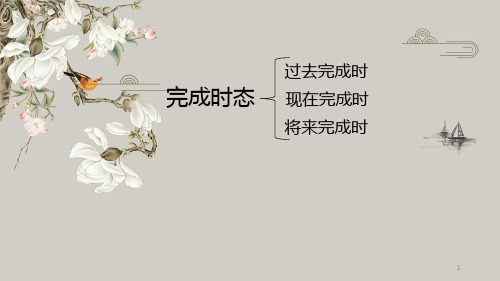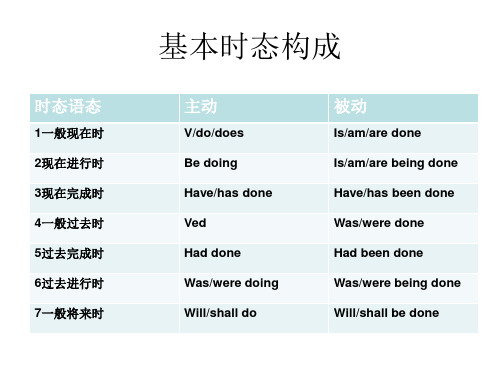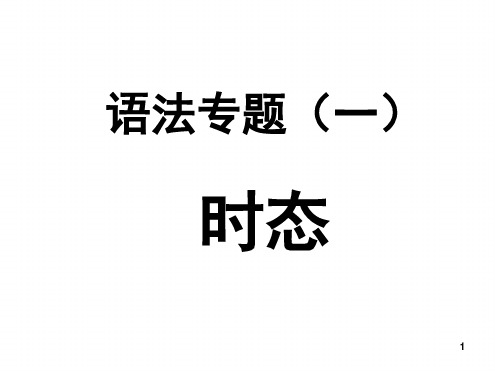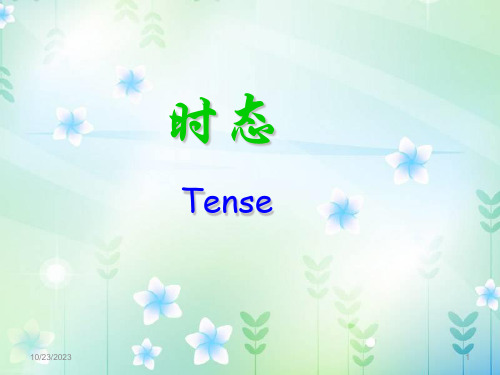现在完成时与过去完成时_ppt
合集下载
英语时态8种基本时态讲解.ppt课件

4)动词过去式变化规则。 a)一般情况下的词加-ed. work---worked call----called b)以不发音的字母e结尾的单词直接加-d . live----lived change----changed smoke----smoked die----died graduate----graduated drive----drove
8.过去完成时 表示动作发生在过去某一时间之前已经完成的动作或状态, 强调“过去的过去”, 常与 by the time, by the end of…,before , by 等引导时间的状语连用。
基本结构 主语+ had + 动词过去分词 + 其他成分 When I got to the cinema yesterday the film had begun already. He had learned English before he came here.
现在完成时与一般过去时的区别: 1)现在完成时侧重于对现在的影响;而一般过去时侧重于某一动作发生在过去某个时间或某段时间。即现在完成时侧重于现在的结果,而一般过去时侧重于动作发生的时间。例如:
I have seen the film. 我看过这部电影。(现在我仍记得电影的内容) I saw the film three days ago. 三天前我看了这部电影。(强调是三天前,而不是别的什么时候看的电影)
be going to含有“打算,准备”的意思,而will则没有这个意思, She is going to lend us her book. He will be here in half an hour.
be about to+V.原形(意为马上做某事,在时间上指最近的将来) I am about to leave school. 不能与表示时间的副词连用。 They are about to set out.(√) They are about to set,变y为i加-ed. study----studied carry----carried cry----cried try----tried d)以元音字母+y结尾的单词直接加-ed. play----played stay----stayed
8.过去完成时 表示动作发生在过去某一时间之前已经完成的动作或状态, 强调“过去的过去”, 常与 by the time, by the end of…,before , by 等引导时间的状语连用。
基本结构 主语+ had + 动词过去分词 + 其他成分 When I got to the cinema yesterday the film had begun already. He had learned English before he came here.
现在完成时与一般过去时的区别: 1)现在完成时侧重于对现在的影响;而一般过去时侧重于某一动作发生在过去某个时间或某段时间。即现在完成时侧重于现在的结果,而一般过去时侧重于动作发生的时间。例如:
I have seen the film. 我看过这部电影。(现在我仍记得电影的内容) I saw the film three days ago. 三天前我看了这部电影。(强调是三天前,而不是别的什么时候看的电影)
be going to含有“打算,准备”的意思,而will则没有这个意思, She is going to lend us her book. He will be here in half an hour.
be about to+V.原形(意为马上做某事,在时间上指最近的将来) I am about to leave school. 不能与表示时间的副词连用。 They are about to set out.(√) They are about to set,变y为i加-ed. study----studied carry----carried cry----cried try----tried d)以元音字母+y结尾的单词直接加-ed. play----played stay----stayed
过去完成时现在完成时将来完成时课件 高三英语语法

Yes, I/we/they/you/she/he had; No, I/we/they/you/she/he hadn’t.
2. 过去完成时的用法:总的来说,过去完成时表示“过去的过去” ① 表示在过去某一时间或动作之前已经发生或完成了的动作。 The film had been on for 5minutes when I arrived at the cinema. I had finished my homework before I began to watch TV. ② 表示从过去某一时间开始,持续到过去另一时间的动作或状态。 Mr. Li had taught English for 8 years in China before he came to America.
10
单项选择
1. --Who will go to the station to meet Lorry?
--I will. I __B___ her several times.
A. met B. have met C. had met D. will meet
2. How long have you __D_____ here?
7
③ 用于一些固定句型,如hardly...when..., no sooner...than..., it was the first time that... Hardly had he seen me when he ran away. I had no sooner reached home than it began to rain. It was the first time this year that he hadn’t worked on a Saturday.
2. 过去完成时的用法:总的来说,过去完成时表示“过去的过去” ① 表示在过去某一时间或动作之前已经发生或完成了的动作。 The film had been on for 5minutes when I arrived at the cinema. I had finished my homework before I began to watch TV. ② 表示从过去某一时间开始,持续到过去另一时间的动作或状态。 Mr. Li had taught English for 8 years in China before he came to America.
10
单项选择
1. --Who will go to the station to meet Lorry?
--I will. I __B___ her several times.
A. met B. have met C. had met D. will meet
2. How long have you __D_____ here?
7
③ 用于一些固定句型,如hardly...when..., no sooner...than..., it was the first time that... Hardly had he seen me when he ran away. I had no sooner reached home than it began to rain. It was the first time this year that he hadn’t worked on a Saturday.
现在完成时与过去完成时PPT课件

4. 和when, before, after, as soon as, until/till 等引导的状语
从Th句e 连ai用rp或la用nhea于d_从__句__中__ already _______(leave)
when I
left
Lasgtotnitgohtt,heasaisropoonrta.s hIad_______________
我已经做完作业了。 I have finished my homework.
表示在说话时已经做完。
在六点以前,我就已经 完 成作业了。 By six o’clock, I had finished my homework.
表示在过去的某一段时间 (six o’clock 以前)已 经做完作业,与现在无关。
结构:助动词 had + p.p.(过去分词)
用法:表示过去某一时间和动作之前已经发生或完成 了的动作或一直持续的动作(过去的过去)。
By the end of last term, we had learned 600 English words. He said he had finished his homework. The film had already begun when we got to the cinema. I had studied English before I came here. When I came to GZ , he had been there for a long
他说他从未看过如此令 人 兴奋的比赛。 He said that he had never seen such an exciting match before!
SUCCESS
现在完成时及过去完成时

误用动词时态
总结词
动词时态使用不当
详细描述
学生在使用现在完成时和过去完成时时,可能会误用动词的时态。例如,应该使 用现在完成时的动词,学生可能会使用过去完成时,或者相反。
忽视时间状语的影响
总结词
忽视时间状语的影响
详细描述
时间状语对于确定应该使用现在完成时还是过去完成时具有重要影响。学生可能会忽视时间状语,导致选择错误 的时态。例如,在描述一个发生在过去的动作,并且该动作在另一个过去的动作之前完成的,学生可能会错误地 使用现在完成时。
用于表示过去的某个动作或状态在更早的时间点已经完成,并对过去某个时间点之 后的情况产生影响。
用于表示过去的某个动作或状态在更早的时间点已经完成,但与现在的情况无关, 只是为了描述过去的某个事实。
03
现某个动作或状态从过去一直持续 到现在,并且可能继续下去。
练习4
He ____(not finish) his homework yet.
I ____(not see) the film yet.
They ____(not know) the answer.
She ____(not buy) a new car.
解析
练习1答案与解析
练习2答案与解析
练习3答案与解析
过去完成时
表示某个动作或状态在过去某个时间 之前已经完成。
用法的比较
现在完成时
强调动作或状态对现在的影响,或者表达一种经验、经历或 结果。
过去完成时
强调动作或状态在过去的某个时间点之前已经完成,通常与 过去某个时间点或动作相关联。
04
现在完成时与过去完成 时的练习与解析
练习题
练习1
练习2
高三英语现在完成时与过去完成时课件(共19张PPT)

A: What had you done before you I _h__a_d_w__a_tc_h_e_d__(watch) TV.
A: What __a_re___ you _d_o_i_n_g__(do) now?
B: I __a_m__w_r_i_t_in_g___(write) a letter to my friend Tom.
The Past Perfect Tense 过去完成时态
have/has+过去分词
1.现在完成时态表示过去发生的动作对现在造成的影响或 结果
Our teacher has left. We have studied English. I have already finished the homework. He has had his lunch. He has become a doctor.
5. 根据上下文判断 I went to Li Hong’s house, but he ___h_a_d_g_o_n__e__(go) out.
Fill in each blank with the proper verb form: 1. He said that he _h_a_d__w_r_it_t_e_n_ (write) that letter.
So
I
__a_m__a_n_s_w_e_r_i_n(ganswer)
his
A: When _w__il_l____ you ___p_o_s_t__(post) it?
B: I _w_i_l_l _p_o_st__(post) it as soon as I _f_in__is_h___(finish) writing.
5. Mary told me she __h_a_d__m__et___(meet) my mother before.
现在完成时与过去完成时课件

详细描述
例如,“I had already finished my homework (过去完成时) when my mom came home (过去时 间状语从句)”。这句话表示“在我妈妈回家之前,我已经完成了我的作业”。
与将来时间状语从句连用
总结词
现在完成时与将来时间状语从句连用, 通常表示对未来事件的预测或推测。
强调的是过去发生的动作或情况与现在的联系和影响。
02
现在完成时的构成
基本构成
构成
主语 + have/has + 过去分词
过去分词变化规则
be动词的过去分词是been,其他动词的过去分词可以通过添加-ed或-d表示。
助动词have/has的意义与用法
01
have/has表示“有”的意思,用 于现在完成时表示“已经拥有” 的状态。
THANKS
感谢观看
05
过去完成时的构成
基本构成
过去完成时是表示在过去某一时间之 前已经完成的动作或状态。
基本构成:助动词had + 动词的过去 分词形式。
助动词had的意义与用法
had是助动词,表示过去完成时的时态,它 本身没有实际意义,只是用来构成过去完成 时的形式。
had的用法:在过去完成时中,had用于表 示动作或状态在过去的过去已经完成。
过去完成时概述
定义与用法
定义
过去完成时表示在过去某一时间之前已经完成或完成的动作或状态。
用法
常用于描述过去的过去发生的事情,通常与过去时态连用,例如“When I got home, I realized that I had left my keys on the counter.”(当我到家时,我意识到我把钥匙落在柜台上了。)
例如,“I had already finished my homework (过去完成时) when my mom came home (过去时 间状语从句)”。这句话表示“在我妈妈回家之前,我已经完成了我的作业”。
与将来时间状语从句连用
总结词
现在完成时与将来时间状语从句连用, 通常表示对未来事件的预测或推测。
强调的是过去发生的动作或情况与现在的联系和影响。
02
现在完成时的构成
基本构成
构成
主语 + have/has + 过去分词
过去分词变化规则
be动词的过去分词是been,其他动词的过去分词可以通过添加-ed或-d表示。
助动词have/has的意义与用法
01
have/has表示“有”的意思,用 于现在完成时表示“已经拥有” 的状态。
THANKS
感谢观看
05
过去完成时的构成
基本构成
过去完成时是表示在过去某一时间之 前已经完成的动作或状态。
基本构成:助动词had + 动词的过去 分词形式。
助动词had的意义与用法
had是助动词,表示过去完成时的时态,它 本身没有实际意义,只是用来构成过去完成 时的形式。
had的用法:在过去完成时中,had用于表 示动作或状态在过去的过去已经完成。
过去完成时概述
定义与用法
定义
过去完成时表示在过去某一时间之前已经完成或完成的动作或状态。
用法
常用于描述过去的过去发生的事情,通常与过去时态连用,例如“When I got home, I realized that I had left my keys on the counter.”(当我到家时,我意识到我把钥匙落在柜台上了。)
现在完成时态课件

例如,“They has arrived.”(错误),应改为“They have arrived.”(正确)。
其他易错点提示
要点一
忘记在助动词后加动 词的过去分词形式
例如,“I have go to the park.” (错误),应改为“I have gone to the park.”(正确)。
感谢您的观看
不规则动词变化举例
be - was/were have - had
go - went
不规则动词变化举例
do - did see - saw
eat - ate
不规则动词变化举例
01
take - took
02
make - made
03
find - found
04
bring - brought
特殊情况处理技巧
例如
I have already finished my homework.(我已经完成我的作业了。)
否定句结构和用法
现在完成时态否定句的基本结构是
主语+have/has+not&# watched the movie yet.(她还没有看过那部电影。)
疑问句结构和用法
现在完成时态课件
contents
目录
• 现在完成时态基本概念 • 现在完成时态用法详解 • 动词变化规则及特殊情况处理 • 句子结构和用法举例 • 常见错误及注意事项 • 练习与巩固环节
01 现在完成时态基本概念
定义与用法
现在完成时态表示过去发生的动作对现在 造成的影响或结果,或表示从过去某个时 间点开始一直持续到现在的动作或状态。
经历与经验
现在完成时态还可以表示过去的经历或经验,这些经历或经验对现在的情况或 行为产生影响。例如,“He has traveled to many countries.”(他去过很多 国家。)
其他易错点提示
要点一
忘记在助动词后加动 词的过去分词形式
例如,“I have go to the park.” (错误),应改为“I have gone to the park.”(正确)。
感谢您的观看
不规则动词变化举例
be - was/were have - had
go - went
不规则动词变化举例
do - did see - saw
eat - ate
不规则动词变化举例
01
take - took
02
make - made
03
find - found
04
bring - brought
特殊情况处理技巧
例如
I have already finished my homework.(我已经完成我的作业了。)
否定句结构和用法
现在完成时态否定句的基本结构是
主语+have/has+not&# watched the movie yet.(她还没有看过那部电影。)
疑问句结构和用法
现在完成时态课件
contents
目录
• 现在完成时态基本概念 • 现在完成时态用法详解 • 动词变化规则及特殊情况处理 • 句子结构和用法举例 • 常见错误及注意事项 • 练习与巩固环节
01 现在完成时态基本概念
定义与用法
现在完成时态表示过去发生的动作对现在 造成的影响或结果,或表示从过去某个时 间点开始一直持续到现在的动作或状态。
经历与经验
现在完成时态还可以表示过去的经历或经验,这些经历或经验对现在的情况或 行为产生影响。例如,“He has traveled to many countries.”(他去过很多 国家。)
初中英语八种时态讲解最新优质ppt课件

语法专题(一)
时态
1
一般现在时 一般过去时 现在进行时 过去进行时 现在完成时 过去完成时 一般将来时 过去将来时 2
一般现在时
3
一、一般现在时:
概念:经常、反复发生的动作或行为及现
在的某种状况。
时间状语:
always, usually, often, sometimes, every
(day, year, month…), once a week, on Sun
10
are) free tomorrow.
10.I will go there when I _____(have will have, has) time tomorrow. 11.He won't come to the party unle he _____(be, will be, am, is, are) invi 12.I'll wait here until my mother ____(come, comes, will come) back. 13.Please return the book to the lib as soon as you ______(finish, finishe will finish) reading it. 14.Once you _____(see, sees, will see him, you will never forget him.
stud→y studies carry→carries fly→flies
9
1. He______(be, am, is, are) a teacher at No. 2 Middle School. 2. He______(have, has) classes in the afternoon. 3.He______(get, gets) up at half past six every morning. 4.He always _____(come, comes ) to school on time. 5.He ______(study, studies) very hard at his lesson. 6. One and two _____(be, is, are) three. 7. Blue and yellow _____(make, makes) green. 8.The earth _____(move, moves) round the sun. 9.I will go there if I ____( be, will be, am, is,
时态
1
一般现在时 一般过去时 现在进行时 过去进行时 现在完成时 过去完成时 一般将来时 过去将来时 2
一般现在时
3
一、一般现在时:
概念:经常、反复发生的动作或行为及现
在的某种状况。
时间状语:
always, usually, often, sometimes, every
(day, year, month…), once a week, on Sun
10
are) free tomorrow.
10.I will go there when I _____(have will have, has) time tomorrow. 11.He won't come to the party unle he _____(be, will be, am, is, are) invi 12.I'll wait here until my mother ____(come, comes, will come) back. 13.Please return the book to the lib as soon as you ______(finish, finishe will finish) reading it. 14.Once you _____(see, sees, will see him, you will never forget him.
stud→y studies carry→carries fly→flies
9
1. He______(be, am, is, are) a teacher at No. 2 Middle School. 2. He______(have, has) classes in the afternoon. 3.He______(get, gets) up at half past six every morning. 4.He always _____(come, comes ) to school on time. 5.He ______(study, studies) very hard at his lesson. 6. One and two _____(be, is, are) three. 7. Blue and yellow _____(make, makes) green. 8.The earth _____(move, moves) round the sun. 9.I will go there if I ____( be, will be, am, is,
初中英语动词八大时态讲解PPT课件

疑问找助动词:do, does
否定找助动词:don’t ,doesn’t
.Hale Waihona Puke 3二、一般过去时 1、be 式动词:
was were 一般过去时 2、实义动词: 使用动词的过去式 (分为规则与不规则) 疑问否定:. did, did’t 4
三 、现在进行时
Is / am /are + doing (注意现在分词的构成)
六、过去完成时:过去的过去
在过去某时间(或动作)看来已经
完成了的动作 :had + done
常见的句型:
①过去完成时 + by the time …
②过去完成时 + by the end of+ 过去的时间
③过去完成时+ when + 一般过去时的句子
④过去完成时+ before + 一般过去时的句子
1、直接+ing
2、去掉e,+
ing
现在进行 时
3、双写+ing
.
5
四、过去进行时 过去进行时
was / were + doing
注意过去进行时与一般过去时的
区别:
1、意义上:过去进行时指过去某
点或某段时间正在进行的动作;而
一般过去时指在过去的时间里所
发生事实。
2、动词使用的形式. 不同
6
五、现在完成时 1、have/ has + done (动作发生在过去对现在造成的 结果或影响) 2、常见的时间状语或句型 ①already,just,ever,never,yet
考点:主句为一般将来时,从句(条件)
用一般现在时。
•We will not go out if it snows tomorrow.
过去完成时ppt

例如: After he arrived in England, Marx worked hard to improve his English.
马克思到达英格兰之后,努力提高他的英语水平。
(7)动词think, want, hope, mean, plan, intend等用 过去完成时来表示过去未曾实现的想法,希望,打算或意
—Peter , where did you guys go for the summer vacation?
—We________ busy with our work for months, so we went to the beach o relax ourselves.
A. were B. have been C. had been D. will be
D.know
答案 C
解析 句意为:我们于2000年在火车上第一次相遇。我们 两人都立刻觉得我们好像已认识了好多年。that从句中 know的动作发生在句子谓语动词felt之前,因此从句谓语 动词应用过去完成时态。
7.(07安徽26)
C. am reading D. have read
----Were you surprised by the ending of the film?
----No, I _______the book, so I already knew the story?
A. was reading
B. had read
C. would do D. were doing
It took me a long time before I was able to fully appreciate what they __ for me.
马克思到达英格兰之后,努力提高他的英语水平。
(7)动词think, want, hope, mean, plan, intend等用 过去完成时来表示过去未曾实现的想法,希望,打算或意
—Peter , where did you guys go for the summer vacation?
—We________ busy with our work for months, so we went to the beach o relax ourselves.
A. were B. have been C. had been D. will be
D.know
答案 C
解析 句意为:我们于2000年在火车上第一次相遇。我们 两人都立刻觉得我们好像已认识了好多年。that从句中 know的动作发生在句子谓语动词felt之前,因此从句谓语 动词应用过去完成时态。
7.(07安徽26)
C. am reading D. have read
----Were you surprised by the ending of the film?
----No, I _______the book, so I already knew the story?
A. was reading
B. had read
C. would do D. were doing
It took me a long time before I was able to fully appreciate what they __ for me.
16种英语时态讲解PPT课件

10/23/2023
8
五、现在进行时态
现在进行时的基本用法
形式: am/is/are + doing
用法1: 表示说话此刻动作正在进行.
• He is not available now. he is talking on the phone.
• Please don’t make so much noise. I am studying.
时态
Tense
10/23/2023
1
一、时态概述
16种时态 一般动作
现在 一般现在
过去 一般过去
进行动作 现在进行 过去进行
完成动作 现在完成 过去完成
完成进行动 现在完成
作
进行
过去完成 进行
将来 一般将来 将来进行 将来完成 将来完成
进行
过去将来 一般过去将来 过去将来进行 过去将来完成 过去将来完成
此用法常与一些表示动作频率的时间副词连用(副词放在be动词之 后, 实义动词之前).
1) 表示肯定的频率副词: always, frequently, usually, sometimes, often, occasionally, generally 等.
2) 表示否定的频率副词: never, seldom, rarely 等.
10/23/2023
6
四、一般将来时态
一般将来时的基本用法
形式:
will do 或be going to do
用法1: 表示预测将要发生某事,用will或be going to do.
1) be going to 特别意指根据目前的明显迹象来推断某件事 要发生; will 则只是表名说话人认为或相信某件事要发生
新概念英语第三册期末复习——时态(39张PPT)

3) be +不定式表将来,按计划或正式安排将发生的事。??? We are to discuss the report next Saturday.
☆be to和be going to 的用法之比较:??? be to 表示客观安排或受人指示而做某事。而be going to 则表示主观的打算或计划。例如: I am to play football tomorrow afternoon. (客观安排) I'm going to play football tomorrow afternoon. (主观安排)
1. — Look! How wonderful my car is! Oh, Jack. What are you thinking about? Don’t you like it? — I’m sorry I ______ any remark about it in time. I certainly think it’s smart. A. wasn’t making B. don’t make C. won’t make D. didn’t make2. To find the street where I lived in my childhood is no easy task because the city ______ so rapidly all these years. A. is changing B. has changed C. will have changed D. will change3. He ______ quite well, but he hasn’t had time to swim since this summer. A. will swim B. have swum C. swam D. swims4. Jimmy said that he would come to pick me up, but he ____by now. A. hasn’t turned up B. doesn’t turn up C. won’t turn up D. hadn’t turned up
☆be to和be going to 的用法之比较:??? be to 表示客观安排或受人指示而做某事。而be going to 则表示主观的打算或计划。例如: I am to play football tomorrow afternoon. (客观安排) I'm going to play football tomorrow afternoon. (主观安排)
1. — Look! How wonderful my car is! Oh, Jack. What are you thinking about? Don’t you like it? — I’m sorry I ______ any remark about it in time. I certainly think it’s smart. A. wasn’t making B. don’t make C. won’t make D. didn’t make2. To find the street where I lived in my childhood is no easy task because the city ______ so rapidly all these years. A. is changing B. has changed C. will have changed D. will change3. He ______ quite well, but he hasn’t had time to swim since this summer. A. will swim B. have swum C. swam D. swims4. Jimmy said that he would come to pick me up, but he ____by now. A. hasn’t turned up B. doesn’t turn up C. won’t turn up D. hadn’t turned up
初中英语八大时态总结ppt课件

was/ were +ing。
have/ has + ed。
had + ed。
10
一般现在时 一般现在时,在没有be动词和助动词have,has,
或情态动词的情况下,要变为否定句或疑问句 的时候要借用助动词do或者does。
肯: I work here.
否: I don’t work here.
问:Do you work here?
问:Were you working here?
答:Yes, I was./ No, I wasn’t.
最新版整理ppt
16
现在完成时
肯: I have worked here.
否:I have not worked here. 问:Have you worked here?
答:Yes, I have./ No, I haven’t.
2
一般过去时
含义:过去发生的动 作或事情。例如:我 过去在这工作、我见 过她、我吃了一个苹 果。
最新版整理ppt
3
一般将来时
含义:将来要发生的动 作或状态。 例如:我
将在这工作、我将与她 见面、我将吃掉一个苹 果。
最新版整理ppt
4
一般过去将来时
含义:站在过去谈论将 要发生的事情。 例如:
一个月以前我说过,我 将要来长沙工作。 两个
现在进行时
肯: I am working here.
否:I am not working here.
问:Are you working here?
答:Yes, I am./ No, I am not.
最新版整理ppt
15
过去进行时
肯: I was working here. 否:I was not working here.
have/ has + ed。
had + ed。
10
一般现在时 一般现在时,在没有be动词和助动词have,has,
或情态动词的情况下,要变为否定句或疑问句 的时候要借用助动词do或者does。
肯: I work here.
否: I don’t work here.
问:Do you work here?
问:Were you working here?
答:Yes, I was./ No, I wasn’t.
最新版整理ppt
16
现在完成时
肯: I have worked here.
否:I have not worked here. 问:Have you worked here?
答:Yes, I have./ No, I haven’t.
2
一般过去时
含义:过去发生的动 作或事情。例如:我 过去在这工作、我见 过她、我吃了一个苹 果。
最新版整理ppt
3
一般将来时
含义:将来要发生的动 作或状态。 例如:我
将在这工作、我将与她 见面、我将吃掉一个苹 果。
最新版整理ppt
4
一般过去将来时
含义:站在过去谈论将 要发生的事情。 例如:
一个月以前我说过,我 将要来长沙工作。 两个
现在进行时
肯: I am working here.
否:I am not working here.
问:Are you working here?
答:Yes, I am./ No, I am not.
最新版整理ppt
15
过去进行时
肯: I was working here. 否:I was not working here.
现在完成时的课件PPT

肯定句表达注意事项
01
注意区分现在完成时与一般过去时的用法,现在完成时 强调过去发生的动作对现在的影响,而一般过去时只表 示过去的某个动作或状态。
02
注意have/has的变形,当主语为第三人称单数时, have要变为has。
03
过去分词的变化规则需要掌握,包括规则变化和不规则 变化。
03 现在完成时否定句式
针对性辅导
拓展延伸
根据学生的实际情况,教师进行拓展 延伸,提供更多相关知识和练习题目 ,帮助学生进一步提高现在完成时的 运用能力。
针对学生在练习中暴露出的问题,教 师进行针对性辅导,帮助学生解决问 题。
1.谢谢聆 听
肯定句
主语 + have/has + 过 去分词 + 其他成分。
否定句
主语 + have/has + not + 过去分词 + 其 他成分。
疑问句
Have/Has + 主语 + 过去分词 + 其他成分 ?
简略回答
Yes, 主语 + have/has. 或 No, 主语 + haven't/hasn't.
否定句表达注意事项
注意区分现在完成时与一般过去时
现在完成时强调过去发生的动作对现在造成的影响或结果,而一般过去时只表示过去某个时间发生的 动作或存在的状态。
注意have/has的否定缩写形式
have not=haven't,has not=hasn't。
现在完成时疑问句式和回答方
04
式
疑问句构成及用法
特点
具有现在相关的时间参照点,强 调过去动作与现在的联系。
- 1、下载文档前请自行甄别文档内容的完整性,平台不提供额外的编辑、内容补充、找答案等附加服务。
- 2、"仅部分预览"的文档,不可在线预览部分如存在完整性等问题,可反馈申请退款(可完整预览的文档不适用该条件!)。
- 3、如文档侵犯您的权益,请联系客服反馈,我们会尽快为您处理(人工客服工作时间:9:00-18:30)。
Paris and he ____________ would come ( come ) back in a few days.
3. My friend __________ bought (buy) the car two years ago. He
_____________ (have) it for two years. has had
6过去进行时 7一般将来时
Had done
Was/were doing Will/shall do
Had been done
Was/were being done Will/shall be done
The Past Perfect Tense
过去完成时态
have/has+过去分词
1.现在完成时态表示过去发生的动作对现在造成的影响或 结果 Our teacher has left. We have studied English. I have already finished the homework. He has had his lunch.
4. When she got to the cinema, the film ____ had already ____ been (be) on for 15 minutes.
5. Mary told me she ___________(meet) my mother before. had met 6. By six o’clock yesterday evening, I ____________(finish) had finished my homework. 7. I went to Li Hong’s house, but he ____________(go) out. had gone 8. We had __________(arrive) at the station before two o’clock. arrived
He has become a doctor.
2.某个动作从过去已经开始,一直持续到现在,还有可能持续到 将来.动作的持续性要通过一段时间来表示. 一段时间的表达方法有两种: for: +一段时间 for a year Since for two weeks for three years since last week 过去的某一时刻, since nine
B: I _________(post) it as soon as I ________(finish) writing. will post finish
学习过去完成时需注意的两个问题: 1. 过去完成时态的肯定式,否定式,疑问式和简短回答: She had left when got there.
我已经做完作业了。 I have finished my homework.
表示在说话时已经做完。
在六点以前,我就已经完 成作业了。 By six o’clock, I had finished my homework. 表示在过去的某一段时间 (six o’clock 以前)已经做 完作业,与现在无关。
2. 和before + 过去时间点连用 We ____________(arrive) had arrived the station before ten o’clock.
3. 常用于宾语从句中 had written She said that she ______________(write) three e-mails.
He said he had finished his homework.
The film had already begun when we got to the cinema.
I had studied English before I came here. When I came to GZ , he had been there for a long time.
他们已经吃过早饭了。 They have already had breakfast. 在他们到旅馆之前他们已 经吃过早饭了。 They had already had breakfast before they arrived at the hotel.
我从未看过如此令人兴奋 的比赛 I have never seen such an exciting match before! 他说他从未看过如此令人 兴奋的比赛。 He said that he had never seen such an exciting match before!
B: Yes. And he often ________(write) to me. I _______(get) a writes got letter from him yesterday. So I ____________(answer) his am answering letter now. will post A: When ________ you ________(post) it?
A: What had you done before you finished your homework?
B: I _____________(watch) TV. had watched
A: What ______ now? are you _______(do) doing B: I _____________(write) a letter to my friend Tom. am writing A: _____ to him? Do you often ________(write) write
4. Before they arrived here, the film _________ had already ___________ (start). started
Fill in each blank with the proper verb form: A: ________ you ___________(finish) your homework? Have finished B: Yes, I have.
过去完成时态的标志: 1. 和 by + 过去时间点连用, 如: by the time, by then, by last year, by the end of last year/month…, by five o’clock yesterday evening… By the end of last term, they ____________(learn) 10 English words.
Yes, I had.
No, I hadn’t.
2. 如果两个动作紧接着发生,则通常不用过去完成时,
用过去时态即可。 I saw them reading books when I came into the cl my homework, I went out to play.
基本时态构成
时态语态
1一般现在时 2现在进行时 3现在完成时 4一般过去时
主动
V/do/does Be doing Have/has done Ved
被动
Is/am/are done Is/am/are being done Have/has been done Was/were done
5过去完成时
5. 根据上下文判断 had gone I went to Li Hong’s house, but he ____________(go) out.
Fill in each blank with the proper verb form: 1. He said that he ___________ had written (write) that letter. 2. Before he arrived, the train __________(leave). had left 3. By then, they ____________ had worked (work)for eight hours.
4. 和when, before, after, as soon as, until/till等引导的状语 从句连用或用于从句中 The airplane _______ had already _______(leave) left when I got to the airport. had finished Last night, as soon as I _______________ (finish) my work, I went to sleep.
Summary
过去完成时与现在完成时二者 用法基本相同,但现在完成时 以现在时间为基点,过去完成 时则以过去的时间为基点,与 现在无关,即过去的过去。过 去完成时常用于宾语从句中;
结构:助动词 had + p.p.(过去分词) 用法:表示过去某一时间和动作之前已经发生或完成
了的动作或一直持续的动作(过去的过去)。 By the end of last term, we had learned 600 English words.
Fill in each blank with the proper verb form: 1. After he ______________ finished (finish) his work, he went out. 2. Annie told me that his father ____________ had gone ( go ) to
构成?
现在完成时:
助动词have / has + 过去分词
过去完成时:
助动词had + 过去分词
I have known him for three years. 我认识他三年了。 I had known him when I was a student. 我当学生时,就已经认识 他了。
